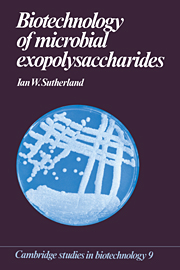Book contents
- Frontmatter
- Contents
- Preface
- 1 Introduction and definition
- 2 Polysaccharide analysis and structural determination
- 3 Exopolysaccharide structure
- 4 Enzymes degrading exopolysaccharides
- 5 Biosynthesis
- 6 Physiology and industrial production
- 7 Genetics, control and regulation of exopolysaccharide synthesis
- 8 Physical properties of exopolysaccharides
- 9 Food usage of exopolysaccharides
- 10 Industrial uses of microbial polysaccharides
- 11 Medical applications of exopolysaccharides
- 12 The future for microbial exopolysaccharides
- References
- Index
8 - Physical properties of exopolysaccharides
Published online by Cambridge University Press: 09 September 2009
- Frontmatter
- Contents
- Preface
- 1 Introduction and definition
- 2 Polysaccharide analysis and structural determination
- 3 Exopolysaccharide structure
- 4 Enzymes degrading exopolysaccharides
- 5 Biosynthesis
- 6 Physiology and industrial production
- 7 Genetics, control and regulation of exopolysaccharide synthesis
- 8 Physical properties of exopolysaccharides
- 9 Food usage of exopolysaccharides
- 10 Industrial uses of microbial polysaccharides
- 11 Medical applications of exopolysaccharides
- 12 The future for microbial exopolysaccharides
- References
- Index
Summary
Studies of the physical properties of exopolysaccharides involve the application of a wide range of techniques; the interpretation of the results also requires a thorough knowledge of the chemical structure of the polymer. Electron microscopy has recently been applied to materials like xanthan to determine the persistence length of the molecule and to ascertain whether it is in a single- or double-stranded form. However, there are many limitations on interpreting the data thus obtained, owing to the possible introduction of artifacts both in the initial recovery of the polysaccharide and in sample preparation. Provided that the exact primary sequence and structure are known, X-ray fibre diffraction can supply information on polysaccharide conformation; circular dichroism provides a sensitive probe of the local environment of cation-binding sites.
Conformation
Determination of the molecular structure and conformation of a bacterial polysaccharide can be accomplished by X-ray diffraction of crystalline samples in the form of fibres. The techniques for orienting and crystallising the polymer use stress fields and annealing in the same way as they are applied to synthetic materials. The detail determined depends on the quality of the fibre diffraction pattern. The periodicity along the polysaccharide chain is visible in the approximately horizontal layer lines of the diffraction pattern. The spacing of the layer lines gives the pitch of the helical structure. Molecular model building can then be used, based on the known chemical repeating unit structure and standard values for bond angles and lengths and ring structures.
- Type
- Chapter
- Information
- Biotechnology of Microbial Exopolysaccharides , pp. 102 - 116Publisher: Cambridge University PressPrint publication year: 1990
- 1
- Cited by



